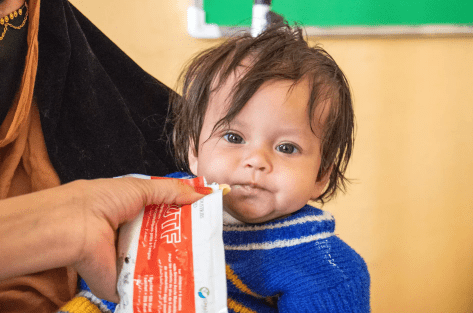
Lately, baby Saida cries a lot. Her father Ghousdin is usually able to calm her down, but her father’s calming voice is not working today. It has been a rough couple of weeks for the 9-month-old baby.
“Three weeks ago, she started vomiting and had bloody diarrhoea. That’s when we knew something was wrong,” explains Ghousdin.
When baby Saida was brought to a health centre in Herat, western Afghanistan, she measured 10cm on the mid-upper arm circumference (MUAC) measuring tape – a simple method to determine the nutritional status of children who are less than five years old. The 10cm reading put Saida in the danger zone of severe malnutrition.
Nutrition counsellor, Aisha, sat with Saida’s mother, demonstrating how to ensure baby Saida gets enough breast milk and other complementary food while maintaining good hygiene at home, especially during food preparation and feeding. Baby Saida got 23 sachets of a ready-to-use therapeutic food (RUTF), an easy to use nut-based paste loaded with the vitamins and nutrients children need.
Beyond RUTF, providing feeding tips for mothers
While baby Sadia cries in the examination room, 8-month-old baby Farishta sits with her mother Rukia in the breastfeeding corner to get advice on breastfeeding and appropriate complimentary feeding advice from the nutrition counsellor. Rukia has walked close to an hour with her baby to get to the health centre. It’s their second visit in a month, to follow up on baby Farishta’s treatment.
“She is doing better today,” says the 18-year-old mother. Baby Farishta had become weak after days without breastmilk. A young, first-time mother, Rukia is learning why it is important to get the right food and nutrients for herself and her baby from these sessions with the nutrition counsellor.
“Many factors contribute to malnutrition,” Aisha tells Rukia. “In some cases, mothers are not able to breastfeed appropriately or are not producing enough breastmilk for the baby. We also see an increase in malnutrition among children whenever there is an outbreak of acute watery diarrhoea in this area, especially between the months of June and August.”
When children do not get enough nutrients, the impact can be long-lasting. It can lead to impaired growth and development known as stunting which can affect school performance later in life and puts children at a higher risk of dying from infectious diseases.
In Afghanistan, about 10 per cent of the children under the age of five are malnourished while 45 per cent of children under the age of five are stunted, largely the resulting from children eating limited variety, and not getting enough nutritious food. Nearly a third of Afghan babies are not exclusively breastfed in their first six months. Exposure to contaminated liquids or food also places babies at a greater risk of life-threatening illnesses which worsens their malnutrition.

Closing the gap on malnutrition
With support from the Government of Japan, Asian Development Bank, the World Bank, the Afghanistan Humanitarian Reconstruction Trust Fund, USAID’s Bureau for Humanitarian Assistance, Afghanistan Humanitarian Fund, Global Affairs Canada, and European Civil Protection and Humanitarian Aid Operations (ECHO) and other partners, UNICEF delivers RUTF to over 3,300 health centres to treat severe malnutrition among children. Between January and November 2023, over 90 million packets of RUTF were distributed across Afghanistan, helping 665,033 children like Sadia and Farishta recover from malnutrition.
UNICEF also supports in-service training of health workers including nurses and nutrition counsellors who teach mothers how to feed babies and young children, beginning with breastfeeding.
Baby Saida has gained half a kilo since her last visit. She gets 14 more packets of RUTF to take her through the next phase of recovery. In the next room baby Farishta is breastfeeding again, her appetite restored as her mother continues to get breastfeeding tips.






